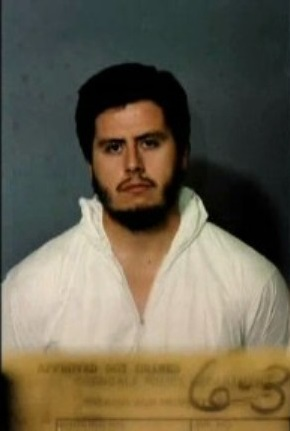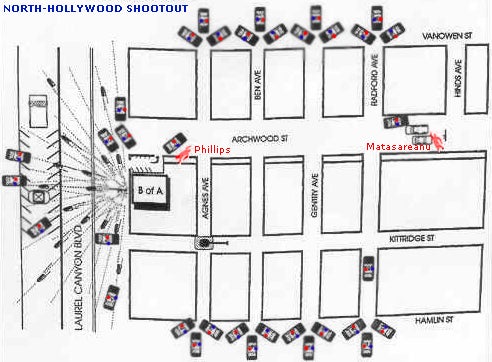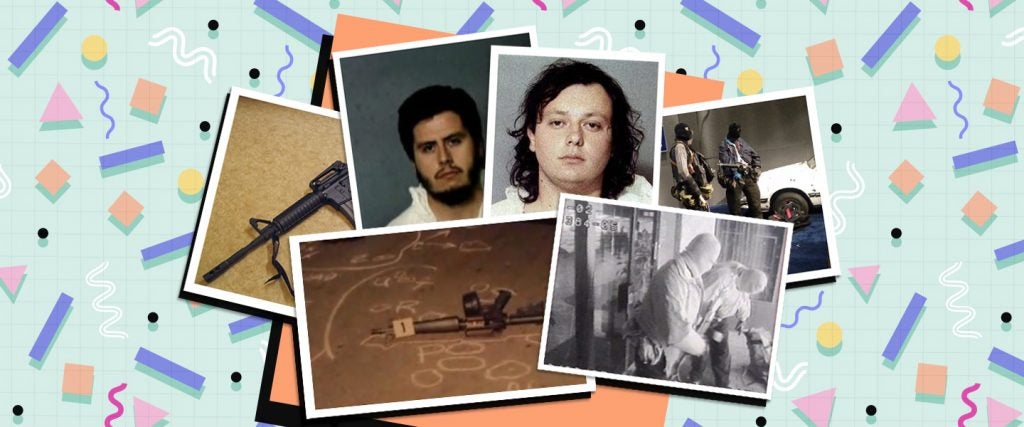2022 marks the 25th anniversary of the year that everything happened — 1997. It was an ear-biting, Pierce Brosnan-loving, comet-obsessed world, and we’re here to relive every minute of it. Twice a week over the next 12 months, we will take you back to the winter of sheep cloning and the summer of Con Air. Come for the Chumbawamba, and stay for the return of the Mack. See all of the stories here.
Between 1985 and 1995, Los Angeles experienced 17,106 bank robberies. According to the L.A. Times, the city’s bank robbers of that era were so prolific that to keep them all straight, the FBI and LAPD gave the suspects highly memorable nicknames: the “McDonald’s Bandit,” suspected of robbing seven banks, had a habit of holding a cup from a fast-food spot; the “Huck Finn Bandit” liked to use a bicycle as his getaway vehicle; and the “Black Nylon Bandits,” credited with 14 robberies, wore — you guessed it — pantyhose over their faces and heads.
The numbers, however, didn’t perturb law enforcement as much as the new trend in “takeover” robberies. State and federal officials watched as the violence of each heist began to escalate, culminating in the now infamous North Hollywood robbery and a 44-minute shootout with the LAPD that would forever change the shape of policing in America.
Prior to this, bank robbers in Southern California had essentially been allowed to strike with impunity. The FDIC insured the stolen sums, so banks told employees to offer no resistance, comply with the robbers’ demands and then get back to business. According to Peter Houlahan’s article “The Rise and Fall of the Bank Robbery Capital of the World,” criminals knew the deal, and as such, many weren’t even armed. In what the FBI called “bank licks,” the unarmed robbers would demand whatever money a teller had in their cash drawer, or simply pass a note over the counter. The banks more or less considered the resulting losses a cost of doing business.
Things started to change, though, after a September 1991 robbery in Tarzana when a Wells Fargo employee broke a cardinal rule by telling the media exactly how much money the bank had lost: a record-breaking $437,000. Gang leader Robert Sheldon Brown, known as “Casper” or “Cas,” from the Rollin’ 60s Neighborhood Crips, heard about the extraordinary pilfered sum, and decided it was time to get into the bank robbery game himself. And so, he turned his teenage gangbangers and corner boys into bank robbers — and he made sure they always brought their assault rifles with them.
The FBI would soon credit Brown, along with his partner-in-crime, Donzell Lamar Thompson (aka “C-Dog”), for the massive rise in takeover robberies. (The duo ordered a total of 175 in the Southern California area.) Although Brown got locked up in 1993, according to Houlahan, his dream took hold — the takeover robbery became the crime of the era. News imagery of them even inspired filmmaker Michael Mann to make his iconic heist film, Heat, which, in turn, would inspire two L.A. bodybuilders to put down their dumbbells and take up outlaw life.
* * * * *
Larry Phillips met Emil Matasareanu at Gold’s Gym in Venice. The two men bonded over weightlifting and became fast friends. They also loved to watch heist films — especially Heat. Eventually, they decided to turn their fantasies into reality. And after their first few jobs, they earned a nickname from authorities, too: the “High Incident Bandits.”
Their first robbery was an armored car job. It was June 1995, when Phillips and Matasareanu, armed with modified fully-automatic assault rifles, walked up to a Brinks truck parked outside a Bank of America in Canoga Park and shot the armed guard, killing him, as over a dozen people watched. The robbers never asked 51-year-old Herman Cook to hand over any money — they just opened fire.
Nine months later, they more or less attempted the same thing. This time, they were driving in the opposite direction of a Brinks truck when one of them aimed his assault rifle out of the passenger window and fired five rounds. The bullets ricocheted off the bulletproof windshield, however, so Phillips and Matasareanu made a U-turn and gave chase. After they failed to catch the armored vehicle, they ditched their van and set it on fire — just like they’d seen in Heat.
Not long after that, the two men robbed the same Bank of America where they’d shot Cook to death, making out with $750,000 in cash. When the FBI arrived to canvass the crime scene for clues, they focused on the surveillance videos. The agents were struck dumb by the sight of the two bodybuilders. Both armed with modified assault rifles, they were outfitted in body armor from head-to-toe, their faces shrouded by balaclava-style ski masks. Even their eyes were covered by sunglasses. They also used their assault rifles rather liberally. Case in point: One of them told a mother of small children that if she didn’t get her kids in line and stop them from crying, he’d kill them.
But mostly, the FBI was taken aback at how the men seemed to take their time. Most bank robberies lasted less than two minutes, but Phillips and Matasareanu took six minutes during their first job and eight minutes during the next. It was as if they had all the time in the world and nothing to fear.
Matasareanu was from Romania, and in 1993, he brought his wife and son to the U.S. as well. Together, they lived with his mother in a home where she ran a “home care service for the mentally disabled.” But after a neighbor alleged that Matasareanu abused one of the residents under her care, his mother kicked him out. By 1996, his wife had left him, too, taking their son with her. By then, his mother feared that Matasareanu had become suicidal and that he might hurt others on his way to taking his own life. “He cannot handle it anymore, those were his words. He just said to me that he wanted to die. His actions were more of a suicide mission,” she would later tell the L.A. Times.

Meanwhile, Phillips, the younger of the two, was a career criminal. In 1991, he was investigated for real estate fraud after getting arrested on a weapons charge. The next year, he was arrested for a residential burglary. And in 1993, the two men were arrested together after police discovered “AK-47s, 9-millimeter handguns, six smoke grenades, two homemade explosives and a gas mask” in their red Thunderbird. The officers also found “police scanners, bulletproof vests, a stopwatch, gloves, sunglasses, wigs, ski masks and other clothing,” per the L.A. Times. The duo was sentenced to four months in county jail.

“These two guys were loaded for bear, but had no serious prior contacts with police,” Deputy District Attorney James Grodin told the L.A. Times. “Normally in something like this, they have a record or belonged to some goofy organization. My recollection is that they said nothing, which makes you more suspicious.”
* * * * *
It was just after 9 a.m. on February 28, 1997, when two officers in an LAPD cruiser driving down Laurel Canyon Boulevard spotted something strange: Two men were walking into a Bank of America looking like they were dressed for a military tour.
Officers Loren Farell and Martin Perello trusted their instincts and called it into dispatch, “15-A-43, requesting assistance. We have a possible 211 in progress at the Bank of America,” Farell radioed. Moments later, they heard gunfire erupt inside the bank.
LAPD officer John Caparelli, who would later write a book about the resulting shootout, remembers when that first call for backup hit the police band airwaves. “The minute we heard the suspect description over dispatch, we knew exactly who these guys were,” he wrote. The responding officers didn’t know it yet, but they’d soon find out that they were dangerously outgunned. A former LAPD officer and weapons expert, Dave Butler, told CNN at the time, “Tactically, the first officers that arrived were at a severe disadvantage. Police carry 15 rounds. They would need to re-load.”
When Phillips and Matasareanu walked into the Bank of America branch at 6600 Laurel Canyon Boulevard, they were ready for war. Both were once again dressed in body armor, balaclava ski masks and sunglasses. They’d also converted bulletproof vests into DIY body armor for their extremities and brought with them modified semi-automatic assault rifles — a Heckler and Koch 91, two Chinese-made weapons — and a modified fully automatic Bushmaster XM15 Dissipator. “I heard gunshots and screaming voices — men’s voices — yelling, ‘This is a holdup!’” 16-year-old eyewitness Matthew Shapiro recalled. “I looked up, and I saw this big guy all in black, like armor. You couldn’t see his face.”
There were 30 customers and employees in the bank that morning, including 39-year-old Anita Hernandez who used her body to shield her 22-month-old granddaughter. Hernandez was shocked at the sight of the enormous man who shoved a gun in her face. “I heard them yelling, ‘All you motherfuckers hit the floor!’ I was afraid that the baby would cry. I was afraid of irritating them.”
Meanwhile, a smattering of responding officers had huddled behind their patrol cars and low brick walls, taking up positions while waiting for the robbers to exit the bank. Inside, Phillips and Matasareanu had grabbed the bank’s assistant manager John Villigrana and demanded he open the vault. He began to stuff money into a bag, but Phillips asked where all the money was. Villigrana informed him that the armored car delivery, which Phillips and Matasareanu had timed their robbery to, had yet to arrive. Frustrated, Phillips unloaded an entire clip into the vault. The 75 rounds tore into what little money was left there. Next, he demanded that Villigrana open up the branch’s ATMs. Villigrana had to inform him that was impossible due to a change in bank protocol.
In all, Phillips and Matasareanu netted $303,305, and after 15 long minutes, they exited the bank. Almost as soon as they stepped outside, they spotted the cops waiting for them and the gunfight began.
Phillips emerged from the north entrance and began firing at a police cruiser. After that, he spied a police chopper hovering above and raised his aim, letting off a burst of rounds at the helicopter’s delicate rotors and glass windshield and forcing it to retreat to safety. He also took aim at the news choppers just above them. Seven police officers were shot in the opening minutes of the gunfight, along with three civilians.
All the while, Matasareanu engaged officers on the south side of the bank. Officer Bill Lantz, fresh out of the police academy, hid behind his bullet-riddled patrol car. “It was like the movie Heat, bullets spraying everywhere. Our car started taking rounds. Plink plink. The windows shattered. The light bar was shattered,” he later said.
The reality of the situation quickly began to sink in for the outgunned police. Over the radio, an officer warned others to stay away, telling them to go against instinct and to let the getaway vehicle go: “They’ve got automatic weapons, there’s nothing we have that can stop them.” “I saw my rounds hit his black jacket, and as I shot at him, he kept coming,” retired officer Thomas Culotta described to the L.A. Times. “Was this a dream? I wasn’t sure, but as this specter made eye contact with me, he pointed his weapon and fired right at me. I remember asking God, ‘Is this the day?’ Death was coming.”
Once LAPD officers realized how desperately they needed more firepower, they made new arrangements. “We need your help! We have an army out there!” an officer shouted to employees of the nearby B&B gun shop. The cops raided the store, resupplying with heavier weaponry. “Police were running in and out of the B&B, and employees were running out with crates filled with guns, bullets and ammunition,” an eyewitness recalled. The gun store owner outfitted the LAPD with 4,000 rounds of “rifle shot” ammo, six semiautomatic rifles and two semiautomatic handguns.
For their part, Phillips and Matasareanu — protected by their body armor and heavily doped on phenobarbital — strolled around the parking lot as they fired their assault rifles with what seemed like endless clips of ammo, just like the bank robbers did at the climax of Heat. Ultimately, Matasareanu ambled over to their getaway car, a 1987 Chevrolet Celebrity. He put it in reverse and backed out of the handicapped spot where he’d left the car running. He was moving slowly, with absolutely no rush at all.
At some point, a cop shot Phillip’s assault rifle. It jammed, so Phillips tossed the gun, then ambled back over to the open trunk of the Chevy, where he casually pulled out a new assault rifle before returning to the gunfight. Soon thereafter, Matasareanu caught a bullet in his eye and another in his rear.
By now, the two men had split up — Phillips on foot and Matasareanu behind the wheel of the shot-up Chevy. After wandering off to a side street, Phillips got into a gunfight with officers. His rifle eventually jammed, and he switched to his Beretta handgun. After he was nearly done with the clip, Phillips turned the gun on himself. His suicide was broadcast live on nearly every major news station in L.A. As Phillips lay dying on the ground, LAPD officers filled his body with a few extra bullets for good measure.

Back in the getaway car, Matasareanu was in shock from his bullet wounds. LAPD officers disabled the Chevy by shooting out two of its tires, so Matasareanu stepped out and attempted to carjack a 1963 Jeep Gladiator. For the next two and half minutes, the gunfight raged on. Then one cop had an idea — he skipped bullets off the pavement so that they bounced up underneath the Jeep Gladiator, hitting Matasareanu in the legs. Matasareanu finally surrendered, before collapsing to the pavement. He’d been shot a total of 29 times.
The officers swarmed Matasareanu, cuffed him and asked for his name. But all he’d say was “Pete.” When the cops asked more questions, he told them, “Fuck you! Shoot me in the head!”
Police let him lie there — possibly for as long as an hour — as he bled to death. Throughout the 44-minute showdown, an estimated 2,000 rounds were fired and 13 people were injured. Amazingly, though, only Phillips and Matasareanu lost their lives.
* * * * *
Since 1997, bank robberies have plummeted in L.A., and it’s no longer the “Bank Robbery Capital of the World.” That title now belongs to its northerly neighbor, San Francisco, the hub of tech wealth. But those days — and the North Hollywood Bank of America robbery especially — haven’t been forgotten. In fact, their perceived lessons are woven into every police department in the U.S.
“It did change the course of law enforcement across this country as we recognize that the proliferation of weapons and firearms and the sophistication of those firearms is only increasing, and is something, unfortunately, we continue to see to this day,” current LAPD Police Chief Michael Moore, an early responder to the shootout himself, recently told the city’s ABC affiliate.
And so, to never be outgunned and underprepared like that again, cops everywhere have armed themselves to the teeth. Which, in the end, might be the real legacy of the “High Incident Bandits” — inspiring the first step toward the militarization of police. It’s a barrel the rest of us have been staring down ever since.

